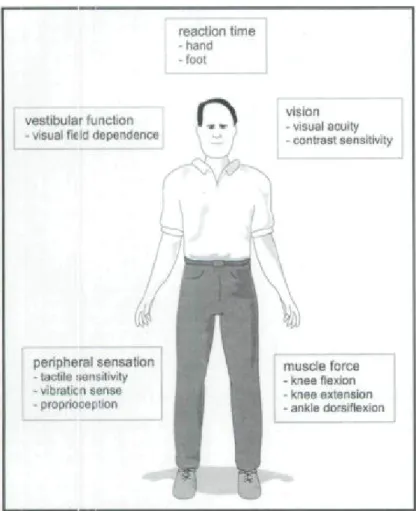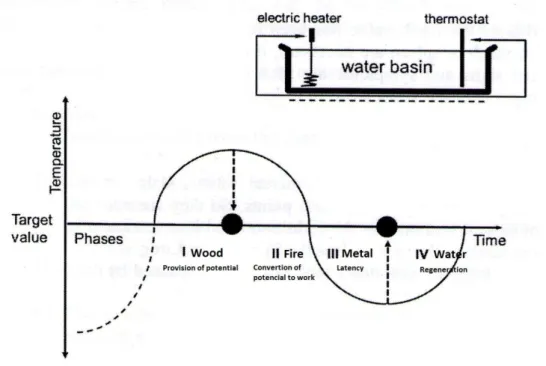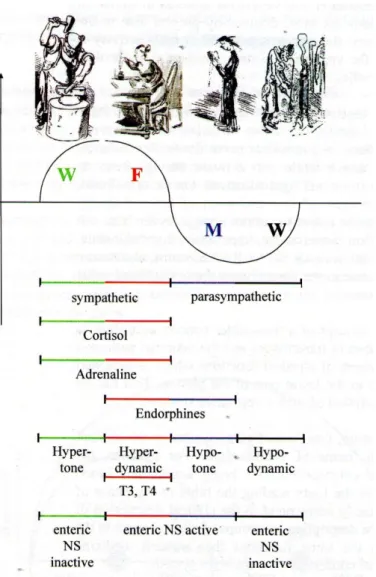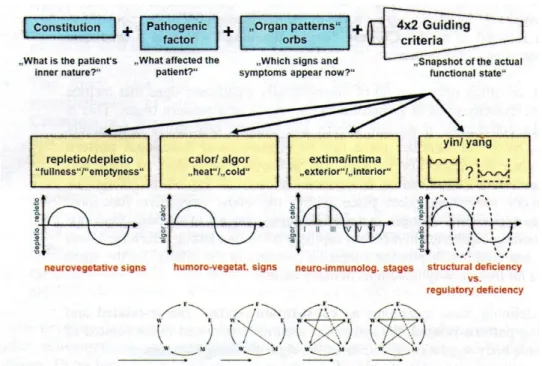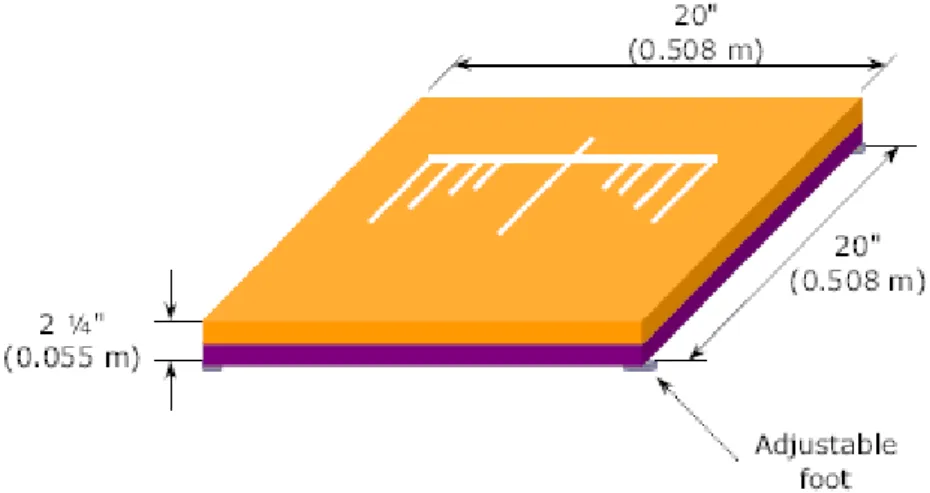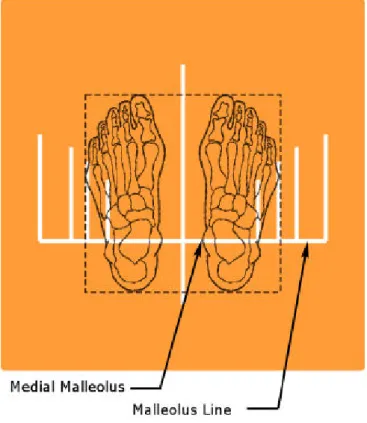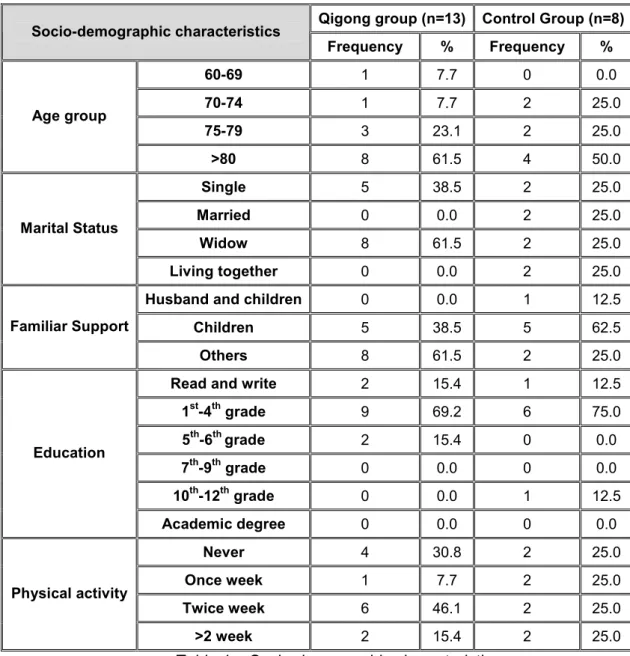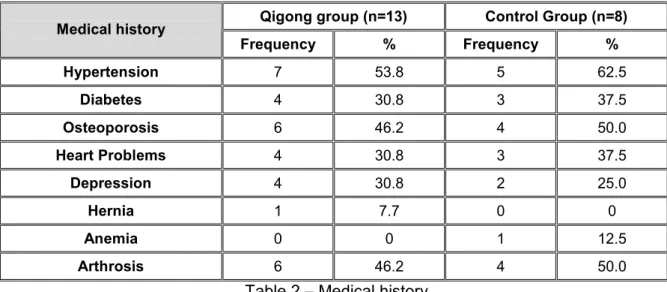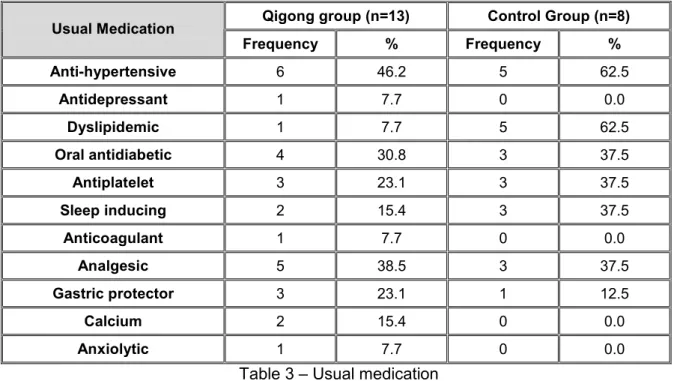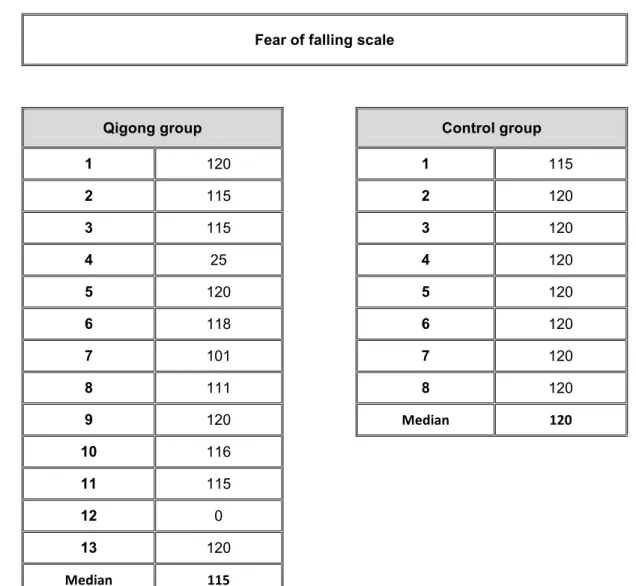“EFFECTS OF QIGONG ON THE BALANCE OF ELDERLY
PEOPLE”
- A feasibility study -
LILIANA FILIPA MARTINS DE SOUSA
Master Thesis of Traditional Chinese Medicine
LILIANA FILIPA MARTINS DE SOUSA
“EFFECTS OF QIGONG ON THE BALANCE OF ELDERLY
PEOPLE”
- A feasibility study -
Master thesis proposal in Traditional Chinese Medicine (TCM) submitted to Instituto de Ciências Biomédicas de Abel Salazar da Universidade do Porto.
Supervision – Doctor Henry J. Greten Category – Associated Professor
Afiliation – Instituto de Ciências Biomédicas de Abel Salazar da Universidade do Porto; Heidelberg School of Chinese Medicine.
Co-supervision – Mário Gonçalves Category – TCM- Qigong Specialist
- iii - ABSTRACT
Background
Falls are associated with serious morbidity among elderly and are one of the most leading causes of death among this population. The ability to maintain postural stability is the most relevant factor for fall prediction, both in community-dwelling as in institutionalised elderly populations. Qigong exercises have been reported in some studies to increase balance parameters and enhance the ability to tolerate unsteadiness.
Objective:
The main objective with this study is to assess if Qigong exercises could improve balance parameters in the elderly. Further objectives are to evaluate parameters related to the loss of postural stability and the occurrence of falls, such as physical activity and fear of falling.
Methods:
A randomized non-blinded controlled clinical trial was conducted. Institutionalized subjects, aged 60 years-old or more, with history of falls were recruited from a nursing home and allocated into 2 groups: (a) Qigong group (n=13) and (b) control group (wait-list group = 8). Qigong self-training exercises were performed during 10 days. The main parameters measured were: (1) static balance by a balance platform; (2) the static balance by single leg stance and (3) the dynamic balance by the up and go test. Measurements were applied before and after the Qigong program to evaluate a possible improvement in balance.
Physical activity and fear of falling were measured at baseline.
Results:
1. Balancecheck platform:
a. There was a statistically improvement of 19.78% in the test on the foam surface with eyes closed in the Qigong group (p-value= 0,003).
b. There were no relevant improvements in the tests on normal surface with eyes closed and on the foam surface with eyes open.
- iv - 2. Single leg stance score test:
a. The score tend to improve in the Qigong group (though not statistically significant).
b. In control group this test score was worsened, indeed it was founded a statistically aggravation of 41.14% (p-value= 0.036).
c. In the comparison between the Qigong and the control group, the Qigong group improved in single leg performance, whereas the control group got worse. This difference was statistically significant (p-value= 0.043)
3. Up and go test score tend to improve in Qigong group after the intervention and worsen in the controls (not statistically significant).
Discussion:
Based on a sample of 13/8, positive improvements were observed for static and dynamic balance parameters when a specified sub-set of Qigong – the so-called White-ball exercises – was carried out. These results are clinically significant since the elders were naïve to the intervention and they performed only a short-term course of Qigong. These exercises may therefore be recommended in such scenarios.
The limitation of the study is the small size of the group resulting in some differences in the baseline values of controls which limits the comparability. The next steps of objectifying possible Qigong effects are to increase the sample size, to apply other objective and subjective tests to assess elder´s balance, to develop an appropriate control intervention, to find additional parameters that may be influenced by the Qigong exercises, and to compare the Qigong effects with other methods improving balance such as physiotherapy and other forms of physical activity / physical exercise. In addition, assessment of the impact of a Qigong long-term programme on the risk of fall would be needed.
Keywords:
Aging, balance, falls, Qigong, Heidelberg model of Traditional Chinese Medicine, fear of falling
- v - RESUMO
Enquadramento:
As quedas estão associadas à grave morbilidade existente nos idosos e estão entre as maiores causas de morte nesta população. A capacidade para manter a estabilidade postural é o fator mais relevante para prever as quedas, tanto para a população idosa na comunidade, como para os que estão institucionalizados. Os exercícios de Qigong têm revelado melhoria nos parâmetros de equilíbrio e capacidade de tolerar a instabilidade.
Objectivo:
O principal objetivo deste estudo é avaliar se os exercícios de Qigong podem aumentar os parâmetros de equilíbrio. Outros objetivos serão analisar outros parâmetros relacionados com a perda de estabilidade postural e a ocorrência de quedas, tal como a atividade física e o medo de cair.
Método:
Foi conduzido um ensaio clínico, randomizado, não cego, e controlado. Indivíduos institucionalizados com mais de 60 anos e história de quedas foram recrutados de um Lar e alocados aleatoriamente em dois grupos: (a) o grupo de Qigong (n=13) e (b) o de controlo (grupo em lista de espera, n=8). Exercícios de Qigong, demonstrados e realizados com os indivíduos durante 10 dias. Os principais parâmetros avaliados foram: (1) o equilíbrio estático, com uma plataforma de avaliação do equilíbrio; (2) o equilíbrio estático através do teste Single leg stance; e (3) o equilíbrio dinâmico, através do teste
Up and Go. As medições foram realizadas antes e após o programa de Qigong de forma
a avaliar uma possível melhoria no equilíbrio.
- vi - Resultados:
1. Plataforma de avaliação do equilíbrio:
a. No grupo de Qigong observou-se uma melhoria estatisticamente significativa de 19.78% no teste da superfície de espuma com os olhos fechados (p=0.003).
b. No grupo de Qigong verificaram-se também melhorias de 0.61% no teste da superfície normal com os olhos fechados e de 1.78% no teste da superfície de espuma com os olhos abertos, embora não estatisticamente relevantes.
2. Teste do “Single leg stance”:
a. Os resultados foram tendencialmente melhores no grupo de Qigong, (embora não seja estatisticamente relevante).
b. No grupo de controlo o resultado deste teste piorou. Verificou-se mesmo uma diminuição estatística significativa (p-value=0.036).
c. Comparando o grupo de Qigong com o grupo de controlo, o grupo de Qigong melhorou na execução do teste “Single leg” enquanto o grupo de controlo piorou. Esta diferença foi estatisticamente significativa (p-value= 0.043).
3. O resultado do teste “Up and go” foi melhor no grupo de Qigong depois do período de intervenção, enquanto no grupo de controlo piorou (embora não seja estatisticamente relevante).
Discussão:
Considerando uma amostra de 13/8, foram observadas melhorias nos parâmetros do equilíbrio estático e dinâmico, quando aplicado um determinado sub-conjunto de exercícios White-ball desenvolvidos com base no modelo de Heidelberg da Medicina Tradicional Chinesa. Estes resultados são muito significativos considerando que os idosos do grupo de Qigong eram naïves para o Qigong e que apenas realizaram um programa de curta duração. Deste modo, estes exercícios poderão ser recomendados para este contexto específico.
- vii -
Como limitação do estudo pode ser referido o reduzido tamanho da amostra que resulta em algumas diferenças nos valores basais do grupo de controlo limitando a comparabilidade.
Os próximos passos para objetivar os possíveis efeitos do Qigong são: aumentar o tamanho da amostra, aplicar outros testes objetivos e subjetivos de forma a determinar o equilíbrio dos idosos, desenvolver uma intervenção com um grupo de controlo apropriado, descobrir parâmetros adicionais que possam ser influenciados pelos exercícios de Qigong e comparar os efeitos do Qigong com outros métodos de melhoria do equilíbrio, tais como a fisioterapia e outras formas de atividades/exercício físico.
Seria necessário também um programa de Qigong a longo prazo na avaliação do risco de queda.
Palavras-chave: Envelhecimento, Equilíbrio, Quedas, Qigong, Modelo de Medicina Traditional Chinesa de Heidelberg, Medo de cair
- ix - ACKNOWLEDGEMENTS
There are many people to whom I owe a debt of thanks for their support in conducting this study:
On a personal note I would like to thank to my family for all their availability... without them this study was not possible... Especially to my husband, Bruno, for his technical and emotional support.
I also would like to acknowledge my supervisors for supporting this study and for their contribute during this time.
A sincerely thank for the 21 elderly subjects institutionalized in “Congregação de Nossa Senhora da Caridade … without them none of this would make sense…and to all workers, especially Diana for their help and cooperation during the research.
To the friends who help me on this journey, especially Clara for their support in data processing and thesis revision, and to the others who accompanied me on this trip...Andreia, Carina, Liliana and Cláudia.
Finally to my little star, who start shining during this course and which represents now the sense of my life…
- xi - ACRONYMS
ALT – Algor Laedens Theory
ANS - Autonomic nervous system
AVC – Acidente vascular cerebral
EEG – Electroencephalography
INE – Instituto Nacional de Estatística
PPA - Physiological Profile Assessment
SLS – Single leg stance test;
TCM – Traditional Chinese Medicine;
TUG – Time Up and go test;
WHO – World Health Organization
- xiii - INDEX
INTRODUCTION ... 19
PART I THEORETICAL FRAMEWORK ... 21
1. The aging process... 23
1.1 Falls in elder people ... 25
1.1.1 Risk factors... 26
1.1.2 Prevention of falls in the elderly ... 28
2. Traditional Chinese Medicine ... 31
2.1 Definition ... 31
2.2 The Heidelberg model of Chinese Medicine ... 32
2.3 Balance according the Heidelberg model of TCM... 36
3. Qigong ... 39 3.1 Overview ... 39 3.2 Qigong/Balance... 43 PART II METHODOLOGICAL FRAMEWORK...45 4. METHODOLOGY ... 47
4.1 Objectives of the study and research question ... 47
4.2 Type of study... 48
4.3 Study variables... 48
4.4 Population and samples ... 49
4.4.1. Inclusion criteria:... 49
4.4.2. Exclusion criteria: ... 49
4.5 Strategy for collecting data ... 50
- xiv -
4.6.1 Psychometric characteristics of the instruments... 51
4.7 Intervention ... 57
4.8 Ethical implications ... 58
5. STATISTIC ANALYSIS... 59
6. RESULTS AND ANALYSIS ... 61
6.1 Socio-demographic characterization... 61
6.2 Clinical data characterization... 63
6.3 “Fear of falling” scale ... 65
6.4 Static balance with direct methods (BalanceCheck platform)... 66
6.5 Static balance with indirect methods (single-leg stance)... 69
6.6 Dynamic balance with quantifiable methods (Up and Go Test)... 71
7. DISCUSSION OF RESULTS... 73
8. CONCLUSION ... 79
9. BIBLIOGRAPHIC REFERENCE... 81
ANNEXES ... 85
Annex I – Questionnaire...87
Annex II – Fear of falling scale...91
Annex III – Authorization request to “Congregação de Nossa Senhora da Caridade”...95
- xv - FIGURE INDEX
Figure 1 – Systems involved in the maintenance of postural stability……….…...23
Figure 2 – Heidelberg model – Chinese medicine as regulation model...33
Figure 3 – Western physiological description of a vegetative sinus wave…….…...34
Figure 4 – The four components of functional diagnosis……….……...35
Figure 5 – Platform diagram …...53
Figure 6 – Foam dimensions…...53
- xvi -
- xvii - TABLE INDEX
Table 1 – Socio-demographic characteristics...……...61
Table 2 – Medical history………...…..63
Table 3 – Usual medication……...64
Table 4 – Falls occurrence……...64
Table 5 – Fear of falling scale…...65
Table 6 – Balancecheck platform…...66
Table 7 – Results obtained from wilcoxin test for balancecheck platform…...68
Table 8 – Single leg stance data…...69
- xviii -
- 19 - INTRODUCTION
The number of adults older than 65 is rapidly increasing in Portugal. According to the latest Census (2011), in 1981 about ¼ of the population belonged to the younger age group (0-14 years), and only 11.4% were included in the older age group (>65 years). In 2011, Portugal has about 15% of the population in the younger age group (0-14 years) and about 19% of the population is 65 or more years old. It´s understandable, from this point of view that issues related to aging process are a concern for health government institutions.
A primary concern for the aging individual is the decline in physical function, which maintenance of balance is primarily affected. On the other hand, lack of balance and gait changes are major risk factors to falls in the elderly (Perracini, 2002). According to WHO (2010), falls are considered the second leading cause of accidental death in the world. In Portugal, several studies show that 40 to 60% of individuals over 65 have experienced at least one fall which was most frequent in nursing homes and among women. (Carvalho, 2004).
As a nurse, I am aware of high rates of hospitalizations due to falls, as the case of thoracic injuries, fractures of the sternum, and splenic, and this fact was also a motivation for this study. This evidence is also reported by Daley (2000) which adds that 32% of elders institutionalized over than 75 years old fall at least once and more than 5% suffer fracture. According to this author falls account for 75% of all fractures and citing Oddsson et al. (2007) the fracture of femur´s neck is the most common and which involves a longer hospitalization.
There are some useful tools in falls prevention, including moderate intensity of physical activity, strength training and flexibility and balance training. One of the most popular practices that blend physical movement or postures and a focus on the breath and the mind to achieve deep states of relaxation are the mind-body practices, which have been recently defined as “meditative movement” (Rogers et al., 2009). In this group is included Qigong: a therapy that harmonizes the total well-being of an individual through simultaneous integrity of structure and function, such as unity of breathing, movement, cognitive processes, emotional states, knowledge and self-consciousness (Posadzki, 2009). According to Heidelberg model it works as a system of biofeedback,
- 20 -
proprioception of vegetative system allowing a deep and higher consciousness and sensibility of the body and promoting a conducted focus.(Greten HJ, 2010).
Indeed, the relatively slow and gentle movements of the Qigong are especially well suited to the elderly and there are many studies proving its effectiveness in balance and postural stability improvement(Spidurso et al., 2005).
To achieve a better understanding about balance in elderly, the main purpose of this study is to evaluate the influence of regular practice of Qigong in their balance, including static balance and dynamic balance.
Static balance may be defined as the ability to maintain posture when stationary and dynamic balance as the ability to maintain balance when the body is in motion. (Wollacott,
1996)
Leading to these objectives, this study is divided in two parts: theoretical and methodological framework.
• The first part discusses the aging process, namely the risk factors of falls and some suggestions for falls prevention. Furthermore, an explanation of the Heidelberg Model of TCM and Qigong is presented as a layground to the experiment.
• The second part includes the methodological framework, includes the methodological framework, in which the objectives of the study are presented, as well as type of study, characteristics of the sample and instruments used for collecting data. Finally research results are presented followed by a discussion on the outcomes.
- 21 -
PART I
- 23 - 1. THE AGING PROCESS
The aging process is a designation for all the processes that occurs in organisms which time lead to a loss of adaptability, functional disability and eventually death (Spidurso et al., 2005)
The maintenance of balance is one of the primarily affected functions, because it depends on the interaction of multiple sensory, motor, and integrative systems that decline with age.
The physiological factors that are the primary contributors to stability are shown in the figure below.
Figure 1: Systems involved in the maintenance of postural stability (Lord, S., Menz H., Tiedemann, A, 2003)
- 24 -
Functioning of each of these factors declines with age, and impairments in each factor are associated with increased risk of falling.
Vision is an important source of sensory information that contributes to the control of balance as it provides information about the position and movements of the body. Visual information is highly effective in moderating the amount of sway and some studies have shown that postural sway while standing increases by 30% when the eyes are closed. (Lord et al., 2005) According to this author “when walking, vision is particularly important for identifying environmental hazards and in determining safe foot placement. In assessing visual ability for the control of balance and gait, different aspects of vision such as contrast sensitivity and depth perception, in addition to standard tests of visual acuity, should be considered.” (Lord et al., 2005, p. 36)
The vestibular sense is also important in balance because it detects position and motion of the head and is important for equilibrium and coordination of head, eye and body movements. The vestibular system involves inner ear structures that contribute to posture through vestibulo-ocular and vestibulo-spinal pathways and there are a number of laboratory-based diagnostic assessments of vestibular function that measure dynamic visual acuity, perception of the upright position, ability to step in place and write vertically with the eyes closed. (Lord et al., 2005)
Sensory information from the lower limbs, which includes proprioception and tactile sensitivity, is arguably the most important contributor to stability because it provides feedback regarding position, movement and touch. (Lord et al., 2005) Quoting Lord et al. (2005, p.37) “proprioception is the awareness of body position, which is determined by information received from receptors in the muscles, tendons and joints” especially the ankle joint. Also tactile information provides additional sensory information to assist in standing balance control. During walking, these structures provide proprioceptive information to help coordinate each step and achieve the desired foot placements.
Lower limb muscle weakness is an important risk factor for falling in elder people, because it manifests in poor balance, abnormal gait patterns and reduced general mobility (Lord et al., 2005).
For last, slowed reaction time is also a mark of ageing process and has been identified as an independent risk factor for falling in older adults. According to Lord et al. (2005, p. 37) “reaction time can be assessed by measuring the time taken to react to a stimulus and is made up of decision time (time to initiate a movement) and movement time (time to carry out the response required).”
- 25 -
As we can see after what was described, maintenance of postural stability is a highly complex skill, which is dependent on the coordination of a vast number of neurophysiological and biomechanical variables.
A marked deficit in any of these factors may be sufficient to increase the risk of falling; however, a combination of mild or moderate impairments in multiple physiological domains may also increase the risk of falling. By directly assessing an individual's physiological abilities, intervention strategies can be implemented to target areas of deficit.
1.1 Falls in elder people
According to the Kellogg International workgroup (reported by Stevens M. et al., 2001, p. 1450) a fall can be defined as “an event that results in a person unintentionally coming to rest on the ground, floor or other lower level.”
The occurrence of falls in older adults is a consequence of the aging process with a significant epidemiological importance. Larson & Bergmann (2008, p.149) relate that “falls occurring in the elderly are clearly life-disrupting events that can result in permanent disability, possible institutionalization or even death”. As seen previously, they have a high susceptibility to injury because of some intrinsic and extrinsic factors. As intrinsic factors one can consider age-related physiological changes (e.g. slowed protective reflexes, hypotension), side effects of medication and a high prevalence of clinical diseases (e.g. osteoporosis, dementia). Extrinsic factors include slippery floors, inappropriate footwear, unstable chairs and obstacles in the way. (Tideiksaar, 2003) Most of these falls are associated with one or more identifiable risk factors (e.g. weakness, unsteady gait, confusion and certain medications), that make even a relatively mild fall particularly dangerous.
According to Lord et al. (2003) the most commonly self-reported injuries include superficial cuts and abrasions, bruises, and sprains. The most common injuries that require hospitalization are femoral neck fractures and other fractures of the leg; fractures of the radius, ulna, and other bones in the arm; and fractures of the neck and trunk.
- 26 - 1.1.1 Risk factors
There are many distinct causes for falls in old people. One of the most important is the gait/balance disorders due to stiffness and less co-ordination that they have in comparison with young people. According to Rubenstain (2006), “posture control, body-orienting reflexes, muscle strength and tone, and height of stepping all decline with ageing and impair ability to avoid a fall after an unexpected trip or slip. In old age, the ‘strategy’ for maintaining balance after a slip shifts from the rapid correcting ‘hip strategy’ (fall avoidance through weight shifts at the hip) to the ‘step strategy’ (fall avoidance via a rapid step) to total loss of ability to correct in time to prevent a fall. Age-associated impairments of vision, hearing and memory also tend to increase the number of trips and stumbles”. There are also other factors, like the dysfunctions of the nervous, muscular, skeletal, circulatory and respiratory systems that can raise the number and severity of falls.
Another extremely common finding among the aged population which is, also, an important risk factor is the muscle weakness. This is a consequence of psychological trauma and fear of falling that produce a downward spiral of self-imposed activity reduction. In fact, the fear of falling associated with reduced physical function, decreases the mobility and increases the functional dependency once there will be metabolic and functional loss (Miller, 1993). From physician point of view, the immobility can be defined as the loss of ability to perform autonomous movements involved in daily living activities, as a result of reduced motor functions. (Freitas et al., 2002) This undermines the independence of the individual and eventually leads to frailty or disability status. According to Freitas et al. (2002) 25% to 50% of the elderly are confined to bed after prolonged treatment, once prolonged immobility generates functional deterioration of the integumentary, skeletal, muscular, cardiovascular, urinary, digestive, nervous, respiratory, endocrine and metabolic system.
Thus we can conclude that even falls that do not result in injury can have serious consequences. (Larson & Bergmann, 2008)
There are other important risk factors like the dizziness, which is an extremely common symptom among older persons that can reflect cardiovascular disorders, hyperventilation, orthostasis, drug side-effect, anxiety or depression. The related problem of orthostatic hypotension can stem from several factors, including autonomic dysfunction (frequently related to age, diabetes or brain damage), hypovolaemia, low cardiac output,
- 27 -
Parkinsonism, metabolic and endocrine disorders and medications (particularly sedatives, antihypertensives and antidepressants). Other specific causes of falls include disorders of the central nervous system, cognitive deficits, poor vision, drug side-effects, alcohol intake, anaemia, hypothyroidism, unstable joints, foot problems, severe osteoporosis with spontaneous fracture and acute illness.
There is another situation that has been reported as an important risk factor for falls, which is the elders’ institutionalization in daycare centers and nursing homes, due to physical, psychological, physiological and also social changes involved. Indeed, after institutionalization the autonomy level of older persons decreases progressively because there is a progressively lack of realization of many routine activities of everyday life, that could improve physical activity. Beyond this disuse, elderly institutionalization can lead to the emergence of situations less beneficial as depression, confusion, loss of contact with reality and a sense of isolation and separation from society. Those situations also lead the elderly to self-restriction of physical activity and sedentary lifestyle (Carvalho et al., 2004).
Because most elderly individuals have multiple identifiable risk factors predisposing to falls, the exact cause can often be difficult to determine but they can potentially be prevented. According to Rubenstain (2006), the most widespread of the risk factor reduction strategies involve regular exercises to improve strength, gait and balance, and results have been promising.
According to Larson & Bergmann (2008, p.148) “the risk of falling can be reduced by modifying known risk factors”. So, the early detection of impairments and functional limitations to perform activities of daily living, safely and effectively, can reduce the risks for injury. In fact “while a marked impairment in just one of the physiological systems that contribute to stability is sufficient to increase the risk of falls, multiple impairments of moderate severity are also associated with increased falls risk.” (Lord et al., 2005, p.38)
Risk factors for falls can be identified through history and examination. Additionally, according to Larson & Bergmann (2008, p.150) “there are many screening tools available to determine the presence of balance and mobility disorders that can assist in the identification of the risk factors associated with falling and can provide objective quantifiable assessments of underlying impairments, as well as functional capacity”. Usually, a simple screening test of gait and balance function, such as the ‘timed up and go’ or Tinetti’s gait and balance test is often useful in identifying gait and muscle dysfunctions. (Larson & Bergmann, 2008) Also the applying of a “Physiological Profile Assessment (PPA)” that involves a series of simple clinical tests of vision, peripheral
- 28 -
sensation, muscle strength, reaction time and balance is reported by Lord et al. (2005) as an important skill to identify risk factors of falls.
1.1.2 Prevention of falls in the elderly
To be successful in prevention of falls in elderly we must attend to a multiple-risk-factor intervention strategy to develop a correct treatment and prevention plan. According to Larson & Bergmann, (2008) there are several approaches available and recommended in the prevention of falls.
An effective one is a program of muscle strengthening and balance retraining, individually prescribed at home by a trained health professional. Larson & Bergmann (2008, p.151) related that “regular physical activity exerts beneficial effects on the functioning of the cardio-respiratory, vascular, metabolic, endocrine, and immune systems”. One the other hand exercise training resulting in active skeletal muscle use may attenuate or even reverse the muscle wasting.
According to WHO (2010) the benefits of physical activity can be classified in three categories:
• Physiological – helps regulate blood glucose levels; improves the quality and quantity of sleep and later improves cardiovascular function, muscle strength, helps preserve and regain flexibility and helps prevent the risks associated with impaired balance and coordination.
• Psychological - promotes relaxation, reduces anxiety and depression mood, improves mental health, and improves motor control and cognitive function.
• Sociocultural - boosts to performance more active roles in society, promotes social and cultural integration, promotes integration and participation in the community, encourages the creation of new friendships and promotes communication between generations.
Another effective action reported by Larson & Bergmann (2008) is a Tai Chi group exercise intervention. In a randomized controlled trial involving a sample of 256 physically inactive, community-dwelling adults aged 70-92, a 6 month Tai Chi intervention demonstrated “statistically significantly fewer falls, lower proportions of fallers and fewer injurious falls than the control group.”
- 29 -
Monitoring the side effects and interactions of medications is also important in falls prevention. Larson & Bergmann (2008, p.152) report that “patients taking psychotropic medications appear to have about a twofold increased risk of falls and fractures, compared with individuals not taking these drugs. So, the evaluation of individuals who are on a number of medications or who are experiencing side-effects that make them prone to a fall is very important to determine if medications can be changed or discontinued to prevent adverse effects on balance and concentration. To reduce the use of antidepressants, often considered the best remedy to depression, studies have found, according to Larson & Bergmann (2008) that 16 weeks of treatment exercise was equally effective. Also Qigong practice has been shown to relieve depression as well as improve self-efficacy and personal well being among elderly people.
Another important action is monitoring and addressing chronic conditions, for example, the effects on the body of Parkinson´s disease, cognitive impairments and a past stroke, to minimize their possibility of becoming a fall factor. (Larson & Bergmann, 2008)
There are other important actions in falls prevention that can include home hazard assessment and modification, that are professionally prescribed for older people with a history of falling; multidisciplinary, multifactorial, health/environmental risk factor screening/intervention program, both for unselected community dwelling older people and for elder people with a history of falling or selected due to a known risk. (Larson & Bergmann, 2008)
According to a study of Stevens et al. (2001) the hazards most frequently implicated in falls were furniture (25%), steps (19%), wet and slippery floors (13%), objects on the floor (9%), and mats and rugs (7%).
- 31 - 2. TRADITIONAL CHINESE MEDICINE
Nowadays, a more critical attitude toward western medicine is steadily growing. In fact, some complaints that the patients have cannot be correlated to a measurable lab finding which makes western medicine little effective. According to Greten HJ (2010, p.11) “60-80% of patients that are chronically ill and have chronic complaints search for help in complementary medicine.”
2.1 Definition
The oldest findings of the Chinese Medicine practice are registered in a book dated back 2300 years, called the “yellow Emperors Classic on Internal Medicine”, However it´s known by archaeological findings that acupuncture needles and traces of herbal treatment date back at least another 4 to 8000 years, although there are no written sources of that medical practice. (Greten HJ, 2010). In fact “the success of Chinese Medicine relies on 3000 years of wisdom and knowledge that has been handed down from generation to generation”. (http://www.die-chinesische-medizin.de/)
However, the central ideas of Chinese Medicine are already mentioned in the aforementioned book and have been more precisely defined through the ages.
The structures of Chinese Medicine can only be understood when one “comprehends their specific terminology or language necessary to enable reference to be made to common established standards.” (Hempen & Chow, 2006, p. 9).
Chinese Medicine has a holistic medical approach, considering the patient in their entirety, by taking careful notice of all information that is available. (Hempen & Chow, 2006). This is an essential prerequisite for the formulation of a diagnosis, which reflect all the subsequent measures in Chinese medicine (in accordance with a predefined terminology). As referred by Hempen & Chow (2006, p. 9) “in order to work effectively and successfully with the therapeutic facilities of Chinese medicine, it is essential to form a diagnosis according to the methods established in that discipline.”
- 32 -
There are a variety of therapeutic processes available in Chinese Medicine. In addition to acupuncture, the most frequently employed therapy is the administration of natural medicines (of herbal, animal and mineral origin) prescribed in combination as a decoction. Use can also be made of specific diet, of movement therapy (tai ji quan, Qigong), and massage treatment (tui na). (Hempen & Chow, 2006)
All the criteria previously defined characterize Chinese medicine as a scientific medicine. Recently there are many health organizations able to enlighten people about the Chinese medicine and its contributions to health. WHO (2008) refers that “many elements of traditional medicine are beneficial and WHO encourages and supports countries to identify practices and remedies safe and effective for use in public and private services.”
2.2 The Heidelberg model of Chinese Medicine
According to Heidelberg model, the TCM can be defined as a system of findings designed to evaluate the vegetative state of a patient. This state can be treated in different forms including reflex actions at central and vegetative nervous system such as acupuncture and manual therapy (Tuina), as well as Qi gong (exercises that activate the vegetative system of biofeedback), but also with herbal and dietetic therapy (i.e. administration of plants and minerals), and through the food itself. (Greten HJ, 2010).
The Heidelberg model of Chinese Medicine understood the Chinese diagnosis as a vegetative state function, which can be raised with almost mathematical rigor. Based on this model is the idea that Yin, Yang and transformation phases represent not only philosophical concepts, but are interpreted as technical terms of regulation theory (cybernetics), as shown in the figure below. (Greten HJ, 2010)
- 33 -
Figure 2 – Heidelberg model – Chinese medicine as regulation model (Greten HJ, 2010)
The Chinese Medicine has now developed a clinical theory of signs, with which one can determine the regulatory status of each of these levels of control on the basis of clinical symptoms. This is the essence of an overall diagnosis. (Greten HJ, 2010)
This Chinese description of body regulation has an equivalent western description of such neurovegetative functions as shown in the next figure.
- 34 -
Figure 3 – Western physiological description of a vegetative sinus wave (Greten HJ, 2010)
The description by groups of clinical signs in the upper part of the figure, which correspond to the clinical description of Chinese medicine, outlines the same functions that western medicine describes as a transmitter and neuronal concert of the vegetative system. (Greten HJ, 2010)
According to Heidelberg model of Chinese Medicine, four main descriptive models have developed to organize the complex relationships of the body regulation. In essence these four "guiding criteria" describe the regulation of the people on four different physiological levels, which together represent a complex network regulation model. These four levels of
- 35 -
control (neurovegetative, humorovegetative, neuroimmunolgical and cellular level) are both Western-how to the Chinese understanding is intimately linked.
Figure 4 – The four components of functional diagnosis.
The constitution is a part of diagnosis which defines the inner nature of the patient as an expression of its physical appearance. This is an important factor because Chinese medicine has the concept that physical structure changes the functional behavior of man, therefore his feelings, functions and the probability of certain symptoms. (Greten HJ, 2010)
The second component of diagnosis is the agent, which makes the patient sick. The agent is a pathogenic factor which offends the normal constitutive behavior and results in the affection of some parts of the body and therefore produces different symptoms which are believed to be abnormal. (Greten HJ, 2010)
The orb is the third major constituent of Chinese diagnosis. Referring to the latin word “orbis”, which means circle, it represents a group of diagnostically relevant signs and findings that are grouped and named after organs where some of the symptoms take place. (Greten HJ, 2010)
- 36 -
After defining these symptoms as constitution-related, factor-related and resulting pattern-related, the symptoms are then interpreted in the context of the whole body regulation by the guiding criteria. Repletion and depletion (“fullness” and “emptiness”) in a western understanding refer to functional capacity mostly induced by the vegetative system. Calor and algor (“heat” and “cold”), the second guiding criterion, refer to the state and the role of microcirculation in the specific clinical scenario of the patient. The third guiding criterion is the extima and intima (the exterior or interior) referring the idea that the body is often offended by external agents that in the case of a lack of defense may invade the interior. For this possible course of disease Chinese medicine has a special teaching which is called the algor-laedens theory (ALT) or model of six stages, the elaborate teaching of cold damaging the body. The fourth guiding criterion of Chinese medicine is the idea of interrelationship of body structure and symptoms. In a western understanding one can say that for a specific body function a certain cell population is necessary. This is part of body structure yin. If the yin is weak, it´s insufficient. This deficiency of body substance, results in changing symptoms caused by overstimulation or lack of function. (Greten HJ, 2010)
All this explanation shows the scientific character of the Heidelberg model which severely contradicts the assumption that Chinese medicine is a “pre-scientific philosophical system” (Greten HJ, 2010, p. 17).
2.3 Balance according the Heidelberg model of TCM
According to Heidelberg model, the phase of generation and geriatrics is the phase water, which includes signs of cerebral paraorb. The brain is called a paraorb (paraorbis cerebri) because it is not a complete orb but is considered to be a “semi-autonomous group of signs” (Greten HJ, 2010, p.7). Among these signs losses of memory, losses of speed of mind, velocity of thinking and general awareness are put into a group as a paraorb. This fact can justify the increasing in the reaction time before an obstacle, which may result in a fall.
Furthermore, if the structure of the body, the yin, is damage by age, the yang is also impaired. This will result in a disturbance of higher nervous functions, as loss of vigilance, disturbances of coordination, disturbance in fine motorics, representing also a risk factor for falls.
- 37 -
One list of these functions could be set forth according to the same principle. The general existence of specific functions belongs to the renal orb or cerebral orb where its fine and fluid regulation in western terms is higher nervous function and fluent fine regulation would be cardiac.
One may considerer this as a specific aspect of the cardio-renal axis. Such a rapport is given when a sort of cooperation, of fine tuning of two orbs is necessary to create proper functions. If the balance of the cardio-renal axis cannot be held, this may result in Water becoming Wood or Fire becoming Metal. As a general example, if the renal orb is not counterbalanced by the cardiac orb, a disturbance of the cardio-renal rapport then muscular spasticity may be seen as a sign of Wood. The average neurological symptom may be of sciatic pain or iratic excitement as by ventus internus. This corresponds to ventus internus within the model of the forth guiding criterion in which a deficiency of yin (water) creates uprising yang in three forms: uprising yang, ardor vigens and ventus
internus. In the language of the first guiding criterion, Water becomes Wood by repletion
(too much energy). In the language of the forth guiding criterion, yin deficiency causes ventus internus (neurological symptoms by uprising, ascending yang functions)
Furthermore, if there is a yin deficiency, the yang deficiency will consequently arise, which causes a lack of upward movement. Having in mind the sinus wave, upward movements may be the Wood, lienal and renal vector, so a yang deficiency may result in:
• Lack of hepatic energies, as general muscle weakness and general lack of drive; • Lack of lienal functions which results in flabby muscles.
• Weak legs and inability to stand up (Renal orb).
A regional lack of microcirculation in the limbs may be called algor leading to the application of the third guiding criterion, the model of six stages (ALT).
This theory argues that there are six slayers of functional powers within the body, which the agents have to overcome when invading the body. These six energy layers set up six major defense mechanisms, which may lead to six stages of defense. The specific signs of these stages are due to two conflicting functional powers, each producing symptoms: the agent and the respective energy of the body.
Splendor yang, stage II (Stomach - Crass intestinal), is the most frequently associated with balance disorders, as they follow the course of the stomach conduit. Furthermore, the centre is the responsible for reaching the Qi into lower limbs.
- 39 - 3. QIGONG
3.1 Overview
Qigong is an integral part of Traditional Chinese Medicine, along with acupuncture, acupressure, and herbal medicine. It is a combination of Qi (life-force, energy, creativity, consciousness, breath, function) and gong (cultivation or practice over time). (www.Qigonginstitute.org)
In a general way it can be described like an over 5000 year-old Chinese health method that combines slow graceful movements with mental concentration and breathing to increase and balance a person’s vital energy. (www.Qigonginstitute.org)
According to Greten HJ (2009) as a biofeedback therapy, Qigong activates psycho physiological self-regulation to restore or maintain a healthy balance overall. Those exercises can be done sitting, standing, moving or lying down.
As reported by Sancier (www.Qigonginstitute.org) there are three intent corrections in Qigong practise. The first one (e.g. mindful adjustment) involves body posture. “Incorrect posture results in decreased or blocked energy flow and the unnecessary expenditure of energy”. (www.Qigonginstitute.org)
The second intent correction involves breathing. The form of breathing most used with Qigong is abdominal breathing, where on inhalation the lower abdomen expands and fills with air before the chest, and the abdomen contracts on exhale. The final intent correction involves mental state or awareness. Regulating the mind is a practice designed to reduce stress and increase the awareness of the moment, helping to achieve a state of pure consciousness by stripping away thoughts and emotions that keep persons unnecessarily immersed in the complexity of daily life. (www.Qigonginstitute.org)
From the point of view of the vegetative system “it is Qigong’s gentle movement that demands more oxygen in the system and helps regulate the body's critical oxygen/carbon dioxide balance. Slow, deep breathing dilates the blood vessels so that the heart doesn’t have to work as hard.” (www.Qigonginstitute.org)
- 40 -
Besides muscle contraction, the main way to enhance the functioning of lymph system is through breathing. The lungs have been called the heart for the lymph system, which is key to body’s immune function as well as removal of toxic metabolic by-products from your cells. “The body goes into a waking regeneration mode during Qigong practice as the nervous system switches from the overactive sympathetic mode to the restorative parasympathetic mode, with an immediate calming effect and an astonishing increase in focused awareness and effective performance.” (www.Qigonginstitute.org)
Also Posadzki (2009, p. 140) refers that Qigong “is a form of complementary therapy and a method of health improvement that tranquilizes the mind and is known to reduce the body’s imbalances”.
Considering this physiologic response with Qigong, there has been an interest in investigating some clinical applications of Qigong, including:
Cardio-respiratory improvements
According to Rogers et al. (2009) the third most frequently published randomized controlled trials related to Taichi and Qigong for older adults on a specific outcome were effects on cardiovascular health. This category includes measures such as blood pressure, BMI, and VO2 max. It has been reported that Qi-training and meditation influence the brainstem and thalamus where numerous cell groups function to influence the autonomic nervous system and sensory input, and thus decrease systolic and diastolic blood pressure. There are also statistically significant increases of heart rate variability.
Also in the feasibility study developed by Sousa et al. (2011) about the effects of Qigong on performance-related anxiety and physiological stress functions in transverse flute music schoolchildren were observed significant reduction in the heart rate by "White Ball" exercises and positive tendencies in reducing anxiety and blood pressure.
It has been suggested that Qi Gong exercises may also alleviate asthma symptoms, as well as modulate inflammation processes. “In asthma patients, Qigong exercises resulted in reduced drug dosage, sick leave, duration of hospitalization and the cost of therapy”. (Posadzki, 2009, p. 141)
- 41 - Psychological Outcomes
The psychological outcome of Qigong has been scientifically studied including through EEG. Posadzki (2009, p.141) refers that “neuromonitoring during Qi Gong appears to objectify the accompanied cerebral modulations with a 22,2% increase in mean blood flow velocity (vm) in the posterior cerebral artery”.
In fact there´s evidence in a cluster of studies that Qigong practice promote perceptual changes such as an individual’s experience of warmness, chilliness, relaxation, tension, and the perception of floating and that it also positively affects the mood changes and relieves exhaustion and tension. (Posadzki, 2009)
The same author refers that Qigong helps to “normalize and stabilize positive and pleasant emotional states of the human mind and improves the overall well-being of an individual. It also relieves depression in chronic physical illness sufferers by improving the individual’s self-identity, social well-being, and quality of life.” (Posadzki, 2009, p.141).
Rhu et al. (cited by Posadzki, 2009) observed the effects of Qi Gong training on the levels of human endogenous opioid peptides, such as beta-endorphin, and other stress hormones, such as adrenocorticotrophic hormone (ACTH). According to the authors the level of beta-endorphin increased significantly during training while the level of ACTH declined during and after training. The result suggests that Qi Gong training, when used as a stress coping method, affects and plays a role in hormonal regulation related to the maintenance of homeostasis in humans (Posadzki, 2009)
Metabolic improvements
According to Posadzky (2009) Qi Gong also includes direct changes in the functioning of the autonomic nervous system (ANS) and therefore may influence metabolic activities. “Body mass index, waist circumstance, level of cholesterol, and albumins excretion can be controlled by means of Qi Gong resulting in an overall improvement in health.” (Posadzki, 2009, p. 141) It is also reported that Qigong can modulate the level of triglycerides, HDL-cholesterol and apolipo-proteins in disorders of lipid metabolism. Also in diabetes there´s evidence that Qigong walking reduced plasma glucose after lunch without inducing a large increase in the pulse rate. (Posadzki, 2009)
- 42 - Qigong in cancer patients
In cancer patients Qigong should be considered as a useful adjunct to cancer therapy adjusting this form of activity to their individual needs.
Indeed Qigong can be useful in the advanced stages of cancer as it helps to reduce vomiting, insomnia, anorexia, facilitates serenity and emotional control, and minimizes distress and helplessness. In cancer patients, the combination therapy reduced the side effects of cancer therapy. (Posadzki, 2009)
Also in a feasibility study developed by Fernandes et al. (2011) with cancer patients is shown that the functional status and global health improved by Qigong exercises.
Neuromuscular and musculoskeletal improvements
It is suggested that Qigong improve motor function and movement coordination.
“The movements in the Qigong exercises may simulate proprioception and functional training.” (Posadzki, 2009, p.141) There is also evidence of beneficial effects of Qi Gong exercises on the active modification of correct body posture. Also in pain management are is worth emphasizing that pain diminished significantly among low back pain sufferers, woman with pre-menstrual symptoms, and chronic pain patients. (Posadzki, 2009)
The gentle activation of the body’s muscles through Qigong exercises may have a positive impact on the patient’s homeostasis. According to Posadzki, “these findings can be interpreted as further support for the value of Qigong in optimizing the patient’s status for more balanced structure and function during recovery processes.” (2009, p.143) Within this framework appears a study of Matos et al. (2011) where consistent changes of skin temperature by infrared thermography were observed after Qigong exercises.
As exposed previously it can be assumed that consequences of regular Qi Gong exercises are overall on health and longevity. As referred by Mayer, (cited by Posadzki et al., 2010, p. 229) “it seems to be a valuable and reliable method to enhance the individual’s health awareness.”
- 43 -
According to Heidelberg model, Qigong exercises allow acquiring strength and security, as they activate the renal orb and therefore make patients free from anxiety. On the other hand, activating some points of the hands has achieved a big balancing and clearing effect. Referring the Qigong as a mind-body practice, according to Heidelberg model by visualizing a purifying effect, the nervous system has a cleaned-up, pain free and emotionally positive impression of the picture or representation of physical and emotional being of the patient. Furthermore by visualizing and activating the concept of self-organizing order, the patient comes to an inner attitude that allows the person to be reorganized by these presumed functional properties that exist according to Chinese Medicine both in the sky and in the body. (Greten HJ, 2010)
Having in mind the concept that emotions originate in the body, by balancing our body functions with Qigong practice, it is automatically balanced and pathogenic emotional patterns within the vegetative nervous system are diminished. So, is possible to achieve a natural feedback for emotional self-healing with Qigong (orthopathy). This kind of inner attitude gives the patient a feedback of their actual subconscious functional state and allows him by imagination to be more balanced for some time. A fraction of this balanced state is then remembered by the tie in the vegetative nervous system and therefore becomes part of the inner being, of inner self-concept. In other words by balancing the vegetative functions and going in the inner posture of attentiveness, the patient has intuitive awareness of subconscious self-regulation. (Greten HJ, 2010)
3.2 Qigong/Balance
Whereby stated above Qigong is a physical activity well suited to the elderly and, as a comprehensive system of corporal techniques with a therapeutic purpose, can improve their balance.
The effects of Qigong in physical function can be observed in three levels of outcomes by Qigong training: functional fitness, functional performance (observed), and functional performance (self-reported). (Spirduso et al., 2005)
Key components of functional fitness include strength, power, flexibility, balance, and endurance. There is evidence in the studies of significantly less loss of grip strength, improvements in stair climb, on balance, in muscle strength.
Functional performance is measured by observed field tests that imitate activities of daily living (Spirduso et al., 2005). In this section there have been noticed improvements in many tests like up and go test, one leg stand, chair rise and gait speed.
- 44 -
In addition to observed measures of functional performance, it is also common to utilize self-reported measure of activities, as instrumental activities of daily living or self-reported health and a fear of falling report. (Spirduso et al., 2005)
The effectiveness of Qigong in balance and in control of factors related to risk of falls has been studied. It has been reported a significant improvement of stance, neural responses, strength and flexibility, and activity levels. There are also other studies relating a significant reduction in falls and in fear of falling scores. (Rogers et al., 2009)
According to Greten HJ (2010) the easy but persistent movements of Qigong exercises allows the achievement of muscle stability, once they activate the microcirculation and work the deeper layers of the muscles of the back known as the true or autochthonous back muscles. This complex muscles group allows the maintenance of upright posture, keeping the body center of gravity within the stability limits. This represents the main advantage of Qigong practice: the relatively slow and gentle movements of the exercises are especially well suited to the elderly and it can be adjusted to the limitations of each person. Indeed, in Qigong practice it´s possible meet the real needs of the patient, once it is customized and prevent patient´s tiredness and exhaustion. As referred previously Qigong exercises can be done sitting, standing, moving or lying down.
Referring the Qigong as a mind-body practice, according to Heidelberg model trough this biofeedback therapy, thinking is directed towards the body and this workout will improve body´s sensitivity and safety.
- 45 -
PART II
- 47 - 4. METHODOLOGY
4.1 Objectives of the study and research question
The starting point for this study emerged from the consciousness that the elderly population increases, increasing public health related burden. On the other hand, according to WHO (2010), falls are translated into very negative consequences for the elderly, representing the second cause of death in this age group. At least, is increasingly recognized the importance of physical activity in the aging process and Qigong answered this purpose once it has consistently produced a number of similar health outcomes. Bearing in mind the benefits of Qigong practice in balance improvement and the fact that there is no similar study known in the referred community, the main purpose of this study is evaluate the influence of Qigong exercises in elder´s balance.
The research question is:
“Does a Qigong exercise improve balance in elderly people?”
Defining the following objectives:
• To evaluate the influence of regular practice of Qigong in balance parameters in elderly people;
• To evaluate other parameters related to the loss of postural stability and the occurrence of falls, such as physical activity and fear of falling.
The purpose of this study is to:
- 48 - 4.2 Type of study
The methodological approach adopted was a prospective, randomized, non-blinded, controlled clinical trial with two groups: Qigong (experimental group) and a wait-list (control group).
According to Goyette (1990) the clinical trial is based on gathering information so numerous and so detailed as possible in order to cover the entire situation. It is why the researcher bails out various techniques for gathering information (observations, interviews, documents).
After evaluation of the proposed parameters, the two groups were compared in order to check if there were statistically significant intergroup differences, in a quantitative approach. “The quantitative research is characterized by expressing itself through numbers or abstract entities” (Ribeiro, 2008, p.79) which is referred to variables meaningful to the conducted research.
4.3 Study variables
The variables selected in the present work were:
• Main variables:
o static balance with direct methods (e.g. a force platform); o static balance with indirect methods (e.g. single-leg stance); o dynamic balance with quantifiable methods (e.g. Up and Go Test) • Socio-demographic variables:
o Age;
o Marital status; o Education;
• Clinical variables;
o Associated diagnoses/ Chronic conditions; o Current medication;
o Previous falls occurrence.
- 49 -
Secondary parameters related to risk factors of falls could be measured to have a broader view of the effects of Qigong, such as fear of falling, physical activity.
4.4 Population and samples
According to Fortin (1996), population is a set of elements or individuals that share common features, defined by a set of criteria, hence it´s an intentional sample, also called a convenience sample. In this study it was defined that the population are the elders of the nursing home of “Congregação de Nossa Senhora da Caridade”, in Viana do Castelo.
The sample was obtained through a set of actions, from the definition of the target population until the establishment of individual and institutional contacts.
The sample consists in 13 elements in the Qigong group and 8 elements in the control group.
4.4.1. Inclusion criteria:
• Seniors, aged 60 or over, who lived in the nursing home; • The motivation to carry out the program;
• Minimum level of fitness to perform independently simple activities of daily living;
4.4.2. Exclusion criteria:
• Mental disorders and cognitive impairments such as dementia or delirium that disallowed participation in the study.
• History of neurological disorders (Stroke).
• Major orthopedic conditions that limit exercises capability (such as severe osteoarthritis).
- 50 -
4.5 Strategy for collecting data
The subjects would be recruited at the nursing home of “Congregação de Nossa Senhora da Caridade”, situated in the district of Viana do Castelo. They would be then randomized into 2 groups: Qigong group and control group. The idea would be to carry with the Qigong group Qigong exercises performed every day, from Monday to Friday, during 10 days.
In the first meeting with the elders the objectives of the study were presented and the schedule for the measurements before Qigong sessions (Up and go test, single leg stance and balance) was defined. A questionnaire was applied to each person, attending the general principles contained in any research: confidentiality and respect for privacy (Bodgan & Biklen, 1994).
The period to obtain this data was from 25th September and 9th October of 2012.
4.6 Instruments for data collection
To select the instruments for data collection, it was considered their suitability in assessing the parameters, their simple application and their national and international use.
• Before first session of Qigong:
o Completion of a questionnaire about socio-demographic, clinical and secondary variables;
o Complete of the “Fear of falling Scale” (FES);
o Measurement of static balance with direct methods (a balancecheck platform);
o Measurement of static balance with indirect methods (single-leg stance);
o Measurement of dynamic balance with quantifiable methods (Up and Go Test).
- 51 -
o Measurement of static balance with direct methods (a balancecheck platform);
o Measurement of static balance with indirect methods (single leg stance);
o Measurement of dynamic balance with quantifiable methods (Up and Go Test).
4.7 Psychometric characteristics of the instruments
a) Socio-demographic and clinical questionnaire
It was applied to the global sample a questionnaire built for this study to access socio-demographic and clinical variables of the patients including sex, age, marital status, familiar support, education level, practice of physical exercise, type of physical activity practiced, medical history, taken medication and falls occurrence. (Annex I)
b) Fear of falling scale (FES)
To evaluate the fear of falling it was applied the Falls Efficacy Scale (FES) validated for the Portuguese population by Melo (2003). This scale was developed to achieve the elderly fear of falling in performing activities of daily living.
This scale consists in questionnaire of 10 tasks which are evaluated in a 10 points scale, where zero (0) represents no confidence and ten (10) lot of confidence. This allows wondering elderly about their level of confidence in performing certain tasks without falling or losing balance.
Thus, lower values mean little confidence or fear of falling and higher values mean lot of confidence or less fear of falling. (Annex II)
- 52 -
c) BalanceCheck platform (According to Bertec ®)
The BalanceCheck Screener series of tests have been designed to assess the patient's ability to maintain balance while standing (static balance).This platform is an instrument that yields objective measurements of patient´s balance progress, allowing the physician to differentiate his practice by incorporating computerized, objective evaluation and documentation using convenient screening and training modules
In the full version of the system, three aspects can be tested: the ability to maintain balance on a hard level surface (Normal Stability, Firm Surface), on a soft surface (Perturbed Stability, Foam Surface), and the maximum movement in the sagittal and lateral directions without losing balance (Limits of Stability).
In this study were available normal stability and perturbed stability. The Normal Stability tests require that the patient stands still on the platform in a comfortable position with the feet symmetrically apart. These are the Eyes Open or Eyes Closed on a Firm Surface tests.
The ability to maintain balance is evaluated in two conditions: with the patient's eyes open, and with eyes closed. These results are compared with standard results obtained for a person of the same height as the patient.
The Perturbed Stability tests require that the patient stands still on a soft foam surface, having a compressible cushion (the foam) placed between the patient's feet and the platform perturbs the equilibrium. These are the Eyes Open or Eyes Closed on a Foam Surface tests.
The ability to maintain balance is again evaluated in two conditions: with the patient's eyes open, and with eyes closed. These results are compared with standard results obtained for a person of the same height as the patient.
- 53 - Figure 5 – Platform diagram (Bertec, 2012)
One of the four platform feet is adjustable. This is provided to accommodate for small variations in the floor where the platform is positioned.
The platform needs to be positioned on a flat horizontal surface. The adjustable foot can only compensate for small variations on the order of ± 1/8" (± 3 mm).
The BalanceCheck foam is to be used in the Perturbed Stability tests. It consists of a square piece of medium density foam inside a vinyl cover, with markings similar to those on the platform to help position the patient's feet.
